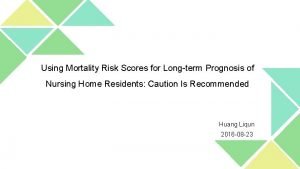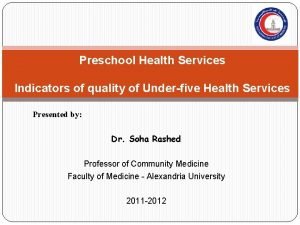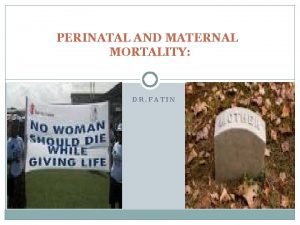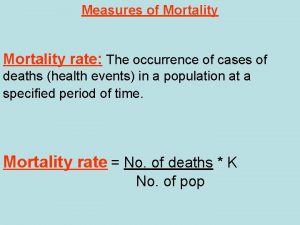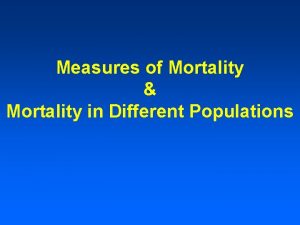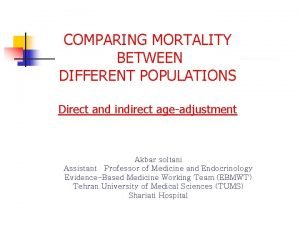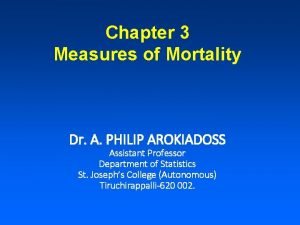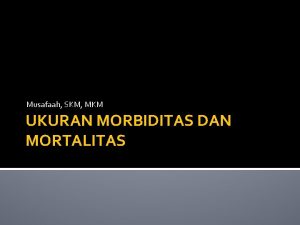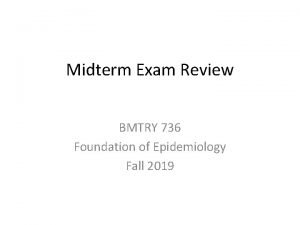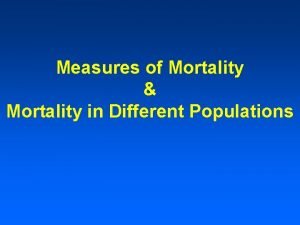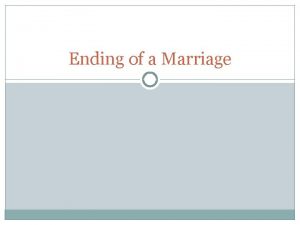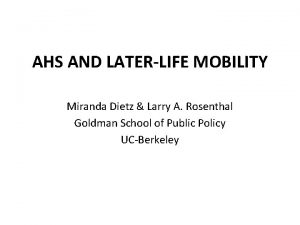Marriage Health and LaterLife Mortality Findings from a





























- Slides: 29

Marriage, Health and Later-Life Mortality: Findings from a sample of Union Army Veterans Sven Eric Wilson Brigham Young University & University of Chicago Prepared for the meetings of the Population Association Meetings of America Philadelphia, PA March 31, 2005

Motivations p Empirically, marital status is strongly associated with health: n n a variety of health measures (mortality, disease, disability, mental health) a wide array of populations and population subgroups. Theory is underdeveloped p High policy-relevance: Do pro-marriage policies promote the public health? p

Persistent Puzzles Although correlations are robust, we still know little about the causal mechanisms. p Furthermore, what do alternative explanations say about questions such as: p n n How should the marriage effect vary across the different categories of non-married—widowed, divorced, separated, never-married? How will the marriage effect vary with age?

Common Explanations p Categories of explanations n Selection p Extensive margin § Not necessarily positive selection p n Capital Accumulation p p p n Intensive margin Behavioral modification Increased return to investment Monitoring Caregiving Social support Bereavement Effects p p Negative psychological effects of spousal loss Positive “bliss effects? ”

The Union Army Data p Extensive information has been collected on over 35, 000 men who served in the Union Army during the Civil War. n n Linked to 1850, 1860, 1900, 1910 census records Military records p p n individual medical records from the civil war hospitals Military experiences—battles, wounds, location of service, etc. Pension records p p p Complete records of physician exams of pension applicants Socioeconmic and demographic information on veterans Family structure in later life: 1900, 1910 census records

Key Variables: Mortality p Mortality: Mortality is measured as the number of days lived past the baseline date n Only those with death dates known are used p n For those in the pension by 1900, over 95% have a reliable death date A small portion of cases have only year of death known —months and days are imputed at the midpoint of the period.

Key Variables: Health Status: p The health information comes primarily from the most recent (prior to 12/31/1900) physical exam n p These are physician recorded, not self-reported. Two indicators of health status at the study baseline are used: n n n BMI: Body Mass Index. Disabling conditions: These are chronic conditions noted by the physicians to be severe enough to merit disability support. Pension Amount: Best measure of severity

Key Variables: Marital Status p p p Marital status is reported in the 1900 census as Married, Single, Divorced or Widowed The Pension Bureau regularly surveyed pensioners and kept dates on marriages and death of spouses Combination of census data and pension data allows us to get at some marital history information, such as whether it is a first or second marriage.

Key Variables: Demographics p Age: n p SES: n n n p Occupation: Home Ownership Employment status (whether ever unemployed during the past 12 months) County Demographics n n n p In the Union Army records, the age is reported at numerous points across the life-cycle. We have developed an algorithm to calculate the “best age” from these disparate sources. Population Density Percent Foreign Born Percent Urban Region (9 census regions)

Sample Restrictions p 35, 570 recruits are in the entire sample n n p Sample used for analysis includes: n n p Over 17, 000 actually enter the pension system at one point. Close to 12, 000 of the veterans alive in 1900 were linked to the U. S. pension schedules, Only those linked to Census in pension system at baseline alive as of June 1, 1900 aged 50 -69 at baseline Total analysis sample: 9, 397

Age distribution p Age (1900)

Sample life table comparisons, 1900 US population numbers come from Haines (1998)

Marital Status, by Age

Sample Demographics

Sample Health Characteristics

Distribution of BMI, 1900, Age 50 -69

BMI Distribution, By Marital Status

Mortality: Married v. Unmarried

Mortality: Marital Status Differences

Regression Methods p Three different methods explored thus far n Probit regression on 10 -year mortality rates p n n p recall there is no significant sample attrition to worry about. Cox Hazard model: censored after 10 years Cox Hazard mode: uncensored Methods yield quantitatively similar results n Probit results presented here.

Probit results; Married v. unmarried

Probit results: Marital status effects

Health Interactions p Marriage effects among those who are underweight, normal and overweight/obese (Not shown: Each model is “full model” containing all covariates)

Summary of Results 1. Married men have consistently lower mortality than unmarried men, even after controlling for health and other demographics. 2. Marriage effects are relatively small (though important in a high mortality environment). 3. The marital status effects are strongest for divorced/separated men. 4. The effects of being unmarried are stronger among those who are underweight than among the normal or the overweight.

Preliminary HRS Comparisons • Using a sample of white men from the 1992 HRS cohort, it is possible to compare the marital status effects between the Union Army (UA) and HRS samples • The UA sample is restricted to follow the same age range as the HRS • Method: A Cox proportional hazard model is used to estimate marital status effects over a ten-year period, with censoring occurring either at loss to follow-up or the end of the period.

UA/HRS Comparison: Marital Status • Distributions of marital status: Males aged 51 -61, 1900 and 1992

UA/HRS Comparison: 10 -year mortality (Descriptive Statistics)

UA/HRS Comparison: Model-Based Marital Status Effects (Cox Model)

UA/HRS Comparison: Summary • Marital status effects are important in both samples. • • • Simple (uncontrolled) effects are much higher in the HRS than in the UA sample. Divorce/Separation has the strongest effect in both samples. Health controls in HRS seem to have a much stronger interaction with the marital status effects than in the UA.
 Morbidity and mortality difference
Morbidity and mortality difference Flacker mortality score
Flacker mortality score Theme of love in the great gatsby
Theme of love in the great gatsby Disease specific mortality rate formula
Disease specific mortality rate formula Equation
Equation Fatin organ
Fatin organ Death rate formula
Death rate formula Age adjusted mortality rate
Age adjusted mortality rate Age adjusted mortality rate definition
Age adjusted mortality rate definition Age adjusted mortality rate
Age adjusted mortality rate Attributable mortality
Attributable mortality Prevalence rate formula
Prevalence rate formula Continuous mortality investigation
Continuous mortality investigation Ukuran morbiditas adalah
Ukuran morbiditas adalah Infant mortality rate formula
Infant mortality rate formula Morality miracle and mystery plays
Morality miracle and mystery plays Infant mortality rate formula
Infant mortality rate formula Menghitung angka kelahiran kasar
Menghitung angka kelahiran kasar An epidemiologic survey of roller skating injuries
An epidemiologic survey of roller skating injuries Neonatal mortality rate formula
Neonatal mortality rate formula Risk behaviours definition pdhpe
Risk behaviours definition pdhpe Imr definition ap human geography
Imr definition ap human geography Presenting insights and findings using written reports
Presenting insights and findings using written reports Attachment a level psychology
Attachment a level psychology Chapter 4 presentation of data
Chapter 4 presentation of data Throat assessment normal findings
Throat assessment normal findings Findings and discussion
Findings and discussion Lamb to the slaughter introduction
Lamb to the slaughter introduction Data analysis research example
Data analysis research example Chapter 4 findings and discussion
Chapter 4 findings and discussion

